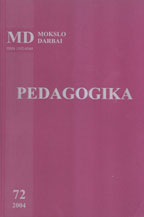Vienovės principas dailės kompozicijoje: meninio ir dvasinio ugdymo pagrindas
The Principle of Unity in Art Composition: Basis of Spiritual and Art Education
Author(s): Dalia MatijkienėSubject(s): Education
Published by: Vytauto Didžiojo Universitetas
Keywords: culture; spirituality; principle of unity harmony; art education; art composition; creativity; axiology; integral personality; artistic symbol; symbolization.
Summary/Abstract: The object of this research — education of art composition. The analysis of the links between art education and spirituality leads to the main question - what brings together these two areas of education. The article deals with the idea that the bonding tie is the principle of unity. The goal of this research - to find theoretical basis for the cohesion between art education and spirituality through the principle of unity in art composition. The methodology used in the research - analysis of scientific literature. There are two theoretical foundations: 1) spirituality —philosophical aspect based on Plato and Aristotle definitions of unity; psychological aspect based on the theories of creativity and personality in humanistic psychology (M. Csikszentmihalyi, A. Maslow); educational aspect which has links with L. Jovaisa's approach to spirituality; 2) art composition — the principle of unity in art composition is based on the definition of an artistic symbol and attributes of unity described by Aristotle. The results of the research - the principle of unity is the basis and the essential premise in art education pursuing the growth of creativity and spirituality. Therefore, the education of art composition must to be based on the principle of unity, i.e. holistic view, based on' anthropology, philosophy, religion. In the content of education of art composition the principle of unity is functioning at several levels: 1. In the content of the subject of art composition it functions as the law of unity, which contains organic, structural and stylistic aspects of composition. 2. As the principle of formation of the content Thus all the elements of the content - means of plastic expression and tools of harmonization -have to bring the unity. 3. As the criteria for evaluation of the created composition of art. 4. As the criteria for the education of an integral and spiritual personality.
Journal: Pedagogika
- Issue Year: 2004
- Issue No: 72
- Page Range: 122-128
- Page Count: 7
- Language: Lithuanian

